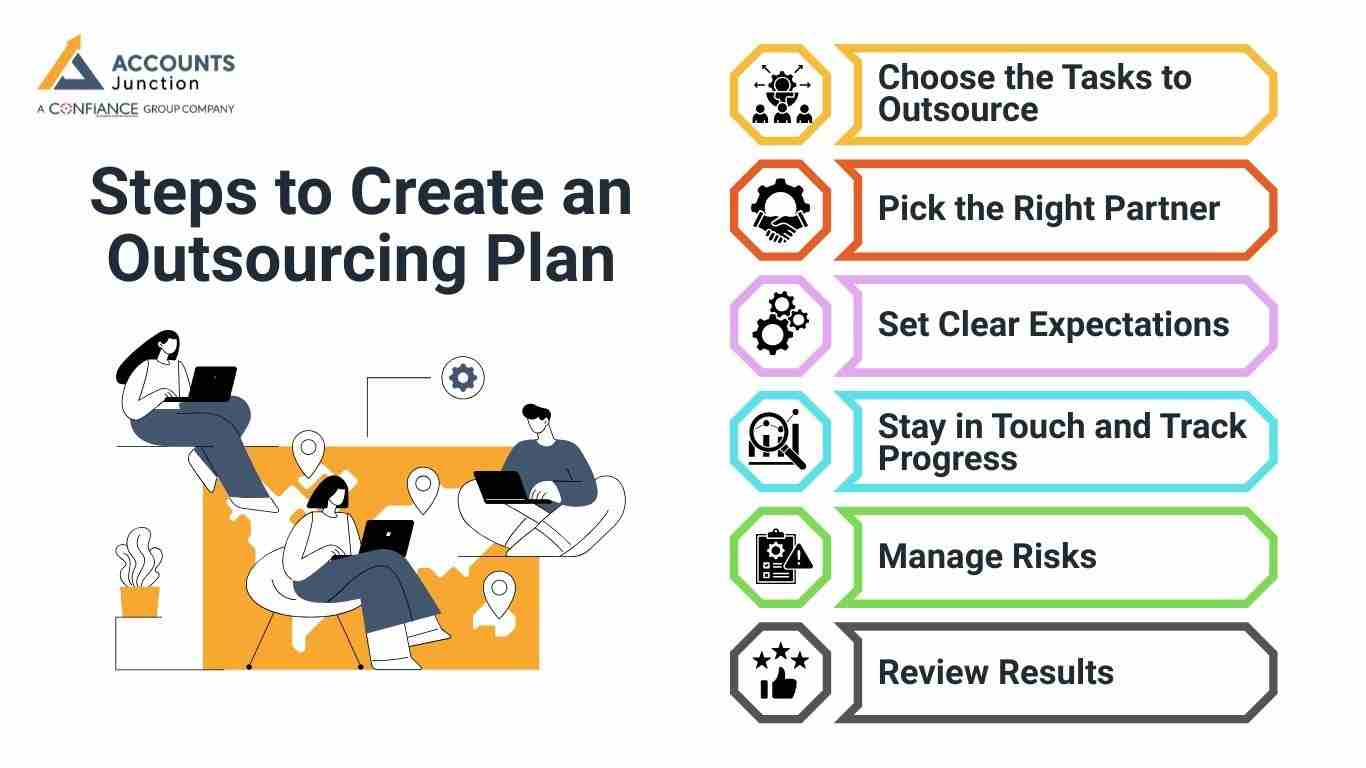
Outsourcing Plan: Why You Need It and How to Make It?
An Outsourcing Plan is an important tool for any business that wants to improve its efficiency, lower costs, and access expert help. Whether you run a small startup or a large company, outsourcing can help your team focus on what matters. This guide will explore why an outsourcing plan is essential and how to create one. We will also look at outsourcing management and business process outsourcing (BPO) to help you understand the full picture.
What Is an Outsourcing Plan?
An outsourcing plan is a simple guide that helps a business hire other companies to do certain jobs. These outside companies can be nearby or in other countries. They may handle work like:
- Customer help
- Tech support
- Pay and bills
- Ads and sales
- Hiring staff
- Typing data
- Making software
A good plan sets clear goals and rules. It helps you get good results and do less work.
Why You Need an Outsourcing Plan
An outsourcing plan helps a business use outsourcing well. It means hiring others to handle tasks that are not key to the business. Without a plan, outsourcing can cause issues and waste money.
An Outsourcing Plan helps by:
-
Cut Costs
Outsourcing helps you spend less on pay, benefits, and office space. You can hire skilled workers from places where costs are lower.
-
Get Skilled Help
Outside teams bring expert skills and the best tools. You don't have to handle these alone.
-
Stay Focused
Your team can spend more time on key work. This includes planning, new ideas, and growing the business.
-
Grow or Shrink with Ease
You can add or cut team size fast. This helps you avoid slow hiring or letting people go.
-
Improve Work Quality
Most vendors have trained staff and good tools. This can lead to better work and happy clients.
-
Lower Risk
Outsourcing groups follow rules and protect your data. This helps you avoid legal and safety issues.
By planning well, you can get the most from outsourcing. Outsourcing management helps keep things running smoothly with business process outsourcing.
Good outsourcing management tracks how well business process outsourcing works.
Steps to Create an Outsourcing Plan
Building a good Outsourcing Plan requires careful thought. To get started, follow these steps.
1. Choose the Tasks to Outsource
First, figure out which tasks to outsource. These are jobs that don’t need much company knowledge, like support, books, or IT.
Ask these questions:
- Which tasks take time but add little value?
- Which tasks need skills you don’t have?
- Which tasks don’t help you beat competitors?
2. Pick the Right Partner
Next, find the right partner. Choose one who can do the work well. Whether you pick BPO or another service, make sure they are skilled and trusted.
Things to look for:
- Skills: The partner must know the tasks well.
- Reputation: Check reviews and ask for past work examples.
- Communication: Make sure they reply quickly and are easy to talk to.
3. Set Clear Expectations
Once you have picked a partner, it is time to set clear goals and rules. You need to define things like:
- Quality: What level of quality do you expect?
- Deadlines: When do you expect the work to be finished?
- Costs: What is the agreed price?
Clear rules help prevent confusion and ensure your partner knows what you expect.
4. Stay in Touch and Track Progress
After starting outsourcing, check in often. Good management means staying in touch to make sure the provider meets your goals.
Here’s how to track progress:
- Weekly updates: Have regular check-ins to see how things are going.
- Performance checks: Use simple measures, like time and cost, to see if the work is on track.
5. Manage Risks
Outsourcing involves risks, so it's crucial to plan ahead. Common risks include:
- Losing control: Outsourcing means less control over the work.
- Data security: You must trust your partner to secure sensitive data.
- Cultural differences: Different languages or cultures may cause issues.
By planning for these risks, you can avoid problems.
6. Review Results
After the task is done, look back at the results. Did the outsourcing help you meet your goals? Was the work done on time and to a high standard? Learning from the results will help improve future outsourcing plans.
What Is Outsourcing Management?
Outsourcing management means working with the companies you hire. When done right, it helps your business get the best deal. This includes picking the right partner, setting clear goals, and checking that things go well.
Key parts of outsourcing management:
- Pick the right provider: Choose a partner with the right skills.
- Set clear goals: Make sure everyone knows what success looks like.
- Track results: Check progress often to avoid problems.
If outsourcing is not managed well, it can lead to delays, poor results, or extra costs.
What is Business Process Outsourcing (BPO)?
Business Process Outsourcing (BPO) is when businesses hire third parties to handle tasks that aren’t part of their main services. These can be tasks like customer service, HR, or finance. BPO lets the business focus on what matters most while experts do the rest. Business process outsourcing cuts costs, while outsourcing management keeps it on track. With good outsourcing management, businesses can boost efficiency through business process outsourcing.
There are two main types of BPO:
Back-office BPO: Tasks like pay, books, and tech help.
Front-office BPO: Jobs with customers, like calls and support.
BPO helps cut costs and boost productivity by using experts.
Real World Examples of Outsourcing
-
Customer Support
A software company hires a support team in the Philippines. This cuts costs in half and keeps users happy.
-
IT Services
A store chain in the United States hires a tech team in India. They manage systems and keep data safe.
-
Marketing and SEO
A new business pays an ad team to do online work. This lets their own team build the product.
-
Accounting and Finance
An online shop hires a firm to track money and pay staff. This helps with taxes and keeps them on the right side of the law.
Outsourcing Challenges and Ways to Handle Them
-
Communication Barriers
Use simple and clear writing. Use tools like Zoom or Slack to stay in touch.
-
Time Zone Differences
Pick teams in nearby time zones or set shared work hours.
-
Data Security Risks
Sign NDAs, use safe tools, and check your vendors often.
-
Quality Concerns
Set clear work rules and review results often to stay on track.
-
Cultural Misunderstandings
Give team training and keep talks open to build trust and teamwork.
When Should You Outsource
Think about outsourcing when these things happen:
- Your team has too much work and gets less done.
- You need skills your team does not have.
- It costs too much to hire or train staff.
- You want to reach a new market fast.
- You need to give support at all hours.
Outsourcing management sets clear goals for business process outsourcing. With a solid plan, outsourcing helps a business improve, save, and focus on key tasks.
Good planning and clear steps make sure things run well and meet your needs. Outsourcing tasks like support, data entry, or payroll saves time and tools for the work that matters most.
Accounts Junction offers expert help with tasks like bookkeeping and payroll, so your team can focus on growth and strategy. With our support, you get smooth service and more time to grow your business.
FAQs
1. What is an outsourcing plan in business?
- It is a structured guide that helps businesses hire external teams efficiently.
2. Why does a business need an outsourcing plan?
- It may reduce costs, improve efficiency, and guide work done by external partners.
3. What are the key steps to create an outsourcing plan?
- Steps may include selecting tasks, choosing partners, setting goals, and monitoring results.
4. Which tasks can a company outsource effectively?
- Routine, time-consuming tasks like payroll, IT support, and customer service are suitable.
5. How do I choose the best outsourcing partner?
- Look at skills, experience, reliability, and communication before signing a contract.
6. What is outsourcing management, and why is it important?
- It tracks outsourced work, sets expectations, and ensures quality delivery from partners.
7. How does business process outsourcing (BPO) relate to an outsourcing plan?
- BPO may handle tasks outside core business functions, guided by your outsourcing plan.
8. What is the difference between back-office and front-office BPO?
- Back-office handles internal tasks like accounting, while the front-office manages customer interactions.
9. How can an outsourcing plan help reduce business risks?
- By defining clear rules, security measures, and monitoring outsourced work closely.
10. What are the common outsourcing challenges businesses face?
- Challenges may include time zone differences, quality issues, and communication barriers.
11. How can technology support outsourcing management?
- Tools like project software, communication apps, and secure cloud storage may improve results.
12. How often should businesses review their outsourcing plan?
- Regularly, such as monthly or after each project, to check efficiency and make updates.
13. Can outsourcing improve work quality?
- Yes, trained vendors with proper tools may deliver higher quality work than in-house teams.
14. How does cost-saving work in outsourcing?
- Businesses may save on salaries, benefits, and infrastructure while accessing skilled talent.
15. Should small businesses create an outsourcing plan?
- Yes, even small teams may gain efficiency, save money, and focus on growth with a plan.
16. How do businesses measure the success of outsourcing?
- Use metrics like task completion, quality standards, time savings, and cost reduction.
17. What are the risks of poor outsourcing management?
- Problems may include delays, higher costs, and poor-quality results if not managed properly.
18. Is it better to outsource locally or internationally?
- Local outsourcing may ease communication, while international options may reduce costs.
19. When is the right time to create an outsourcing plan?
- When a business wants efficiency, skill support, or help managing non-core functions.
20. Can an outsourcing plan help scale a business?
- Yes, it may allow teams to focus on core work and expand operations smoothly.

